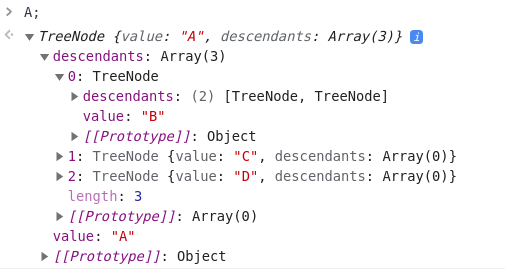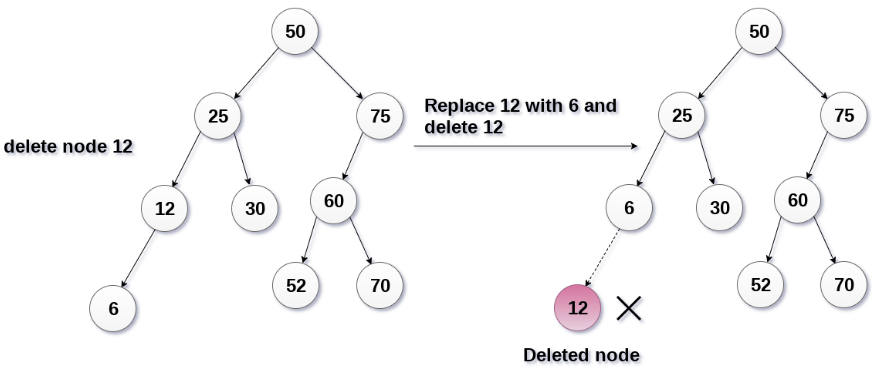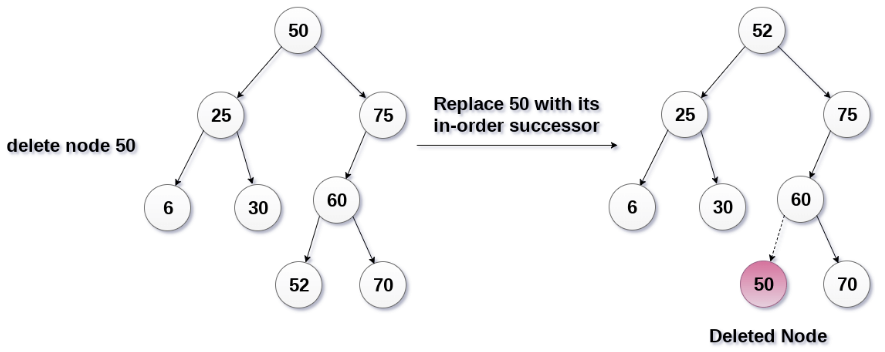
트리의 특징
- 트리구조는 데이터를 선형이 아닌 계층으로 정렬한다.
- Height는 해당 노드부터 리프노드까지의 거리를 의미한다.
- Depth는 노드의 계층(level)을 의미한다.
- 위 예시에서
A의 Height와 Depth는 각각3, 0이고,I는0, 3이다.
- 위 예시에서
- 트리는 뿌리에 해당하는 루트노드를 기준으로 구성된다.
- 상위노드는 부모노드에 해당하며, 하위노드는 자식노드이다.
- 자식노드는 하나의 부모노드만을 가지며, 여러개의 부모노드를 갖는 자료구조는 그래프이다.
- 더이상 자식노드를 갖지 않는 노드는 말단노드 또는 리프노드라고 한다.
- 노드 하나와 그 자식노드로 구성된 트리를 하위트리 또는 서브트리라고 한다.
- 트리에서 노드를 연결하는 선을 에지(edge)라고 한다.
- 노드에는 데이터를 저장하며, 이때 저장된 데이터를 식별하는데 사용되는 키와 값(데이터)을 포함할 수 있다.
트리 적용하기
다음과 같이 value와 descendants를 갖는 노드를 생성할 수 있고, descendants에 각 노드를 푸시해서 계층을 만들 수 있다.
class TreeNode {
constructor(value) {
this.value = value;
this.descendants = [];
}
}
//트리의 노드 생성하기
const A = new TreeNode('A');
const B = new TreeNode('B');
const C = new TreeNode('C');
const D = new TreeNode('D');
A.descendants.push(B,C,D);
const E = new TreeNode('E');
const F = new TreeNode('F');
B.descendants.push(E, F);
console.log(A);A를 콘솔에 찍어보면, 다음과 같이 A.descendants에 각각 B,C,D를 value로 가지는 노드들이 저장되어있고, B.descendants에도 E,F를 value로 가지는 노드들이 저장되어있다.

이진트리
이진트리는 가장 많이 사용되는 데이터 구조라고 할 수 있으며, 각 부모노드는 최대 2개의 자식노드와 연결되어 있어서 붙여진 이름이다. 이진트리의 유형으로는 Full, Complete, Perfect 등이 있다.

-
full binary tree
- 각 노드가 0개 또는 2개의 자식노드를 가진 경우 (1개의 자식노드를 가진 경우는 해당안됨)
-
complete binary tree
- 리프노드를 제외하고 모든 레벨의 노드들이 0개 또는 2개의 자식노드를 가진 경우 (즉, 리프 노드를 제외하고 모든 레벨의 노드가 full binary tree인 경우)
- 만약 위의 예시에서 회색 노드를 지우면, full, complete binary tree이지만, perfect는 아니다.
-
perfect binary tree
- 리프노드 포함 모든 레벨의 노드이 full binary tree이고, 리프노드가 모두 같은 레벨인 경우
- k는 트리의 Height이고, 1부터 시작할때, 약 (2^k)-1개의 노드를 갖는다.
이진 탐색 트리
이진 탐색 트리는 왼쪽 자식노드의 값이 항상 부모노드보다 작고, 오른쪽 자식노드의 값이 항상 부모노드보다 큰 이진트리이다.
(부모노드와 같은 값을 삽입할 경우, 오른쪽 자식노드의 추가하는 경우도 있는데, 이러한 중복값을 추가하는 케이스는 다음에 다루도록 하고, 이번에는 중복값은 허용하지 않는 경우로 살펴보도록 하자.)
이진트리 값 삽입하기
현재 노드를 기준으로 크기를 비교한다.
-
현재 노드 === 삽입할 노드
리턴한다 -
현재 노드(A) > 삽입할 노드(X)
왼쪽 자식노드(B)의 값이 Null이라면 B에 삽입한다.B에 값이 있다면, B를 기준으로 다시 크기를 비교한다. -
현재 노드(A) < 삽입할 노드(X)
오른쪽 자식노드(C)의 값이 Null이라면 C에 삽입한다. C에 값이 있다면, C를 기준으로 다시 크기를 비교한다.
이진트리 값 삭제하기
값을 삭제하는 경우는 세가지가 있다.
- 삭제할 노드가 리프 노드인 경우
삭제할 노드를 Null로 바꿔준다.

- 삭제할 노드가 하나의 자식노드를 가진 경우
삭제할 노드를 자식노드와 위치를 바꿔준 후, 자식노드(원래 삭제할 노드였던 값)를 Null로 바꿔준다.

- 삭제할 노드가 두 개의 자식노드를 가진 경우
트리를 중위순회를 했을때 삭제할 노드 다음값(항상 리프노드)과 위치를 바꿔주고, 리프노드(원래 삭제할 노드였던 값)를 Null로 바꿔준다.

이진트리 순회방법
//다음과 같은 트리가 있을때, 트리를 순회하는 방법은 다음과 같다.
10
/ \
5 30
/ / \
4 15 40
/
3전위순회 Preorder Traversal (DFS와 순서동일)
부모 -> 왼쪽 서브트리 -> 오른쪽 서브트리- 서브트리 방문했을때에도, 왼쪽 노드부터 먼저 순회
10, 5, 4, 3, 30, 15, 40
중위순회 Inorder Traversal
왼쪽 서브트리 -> 부모 -> 오른쪽 서브트리3, 4, 5, 10, 15, 30, 40
후위순회 Postorder Traversal
왼쪽 서브트리 -> 오른쪽 서브트리 -> 부모3, 4, 5, 15, 40, 30, 10
구현
class treeNode {
constructor(data) {
this.data = data;
this.left = null;
this.right = null;
}
}
class bst {
constructor() {
this.root = null;
}
insert(data) {
let node = new treeNode(data);
// 루드가 설정되어 있지 않다면 루트를 node로 만들어 준다. node는 treeNode()에서 뼈대를 받아온다.
if(!this.root) {
this.root = node;
return this;
}
// 비교를 위해 current 를 설정해 준다.
let current = this.root;
// current가 true 라면 while문을 돌면서 data와 지금 현재 data인 current data를 비교한다.
while (current) {
// 중복된 값은 어떤 결과를 리턴하지 않는다.
if(data === current.data) {
return;
}
// data가 기준 data(current data) 보다 작다면 왼쪽에 넣어준다.
if(data < current.data) {
if(!current.left) {
current.left = node;
break;
}
// 이제 current data(기준)는 왼쪽의 data로 잡힌다.
current = current.left;
}
// data가 기준 data(current data) 보다 크다면 오른쪽에 넣어준다.
if(data > current.data) {
if(!current.right) {
current.right = node;
break;
}
// 이제 current data(기준)는 오른쪽 data로 잡힌다.
current = current.right;
}
}
}
// BFS(너비 우선 탐색)
bfs() {
let node = this.root;
let queue = [node];
let finalData = [];
while(queue.length) {
node = queue.shift();
if(node.left) {
queue.push(node.left);
}
if(node.right) {
queue.push(node.right);
}
finalData.push(node.data);
}
return finalData;
}
// DFS(깊이 우선 탐색)
// Pre-Order traversal(전위 순회)
preOrder() {
const finalData = [];
function traverse(node) {
finalData.push(node.data);
if(node.left) {
traverse(node.left);
}
if(node.right) {
traverse(node.right);
}
}
traverse(this.root);
return finalData;
}
// In-Order traversal(중위 순회)
inOrder() {
let finalData = [];
function traverse(node) {
if(node.left) {
traverse(node.left);
finalData.push(node.data);
}
if(node.right) {
traverse(node.right);
}
}
traverse(this.root)
return finalData;
}
// Post-Order traversal(후위 순회)
postOrder() {
let finalData = [];
function traverse(node) {
if(node.left) {
traverse(node.left);
}
if(node.right) {
traverse(node.right);
finalData.push(node);
}
}
traverse(this.root)
return finalData;
}
}🔍 루트노드의 height는 0일까? 1일까?
- height를 엣지의 개수로 본다면 0
- height를 노드의 개수로 본다면 1

위의 예시에서 트리는 height를 엣지의 개수로 본다면 3이고, 노드의 개수로 본다면 4이다.
reference